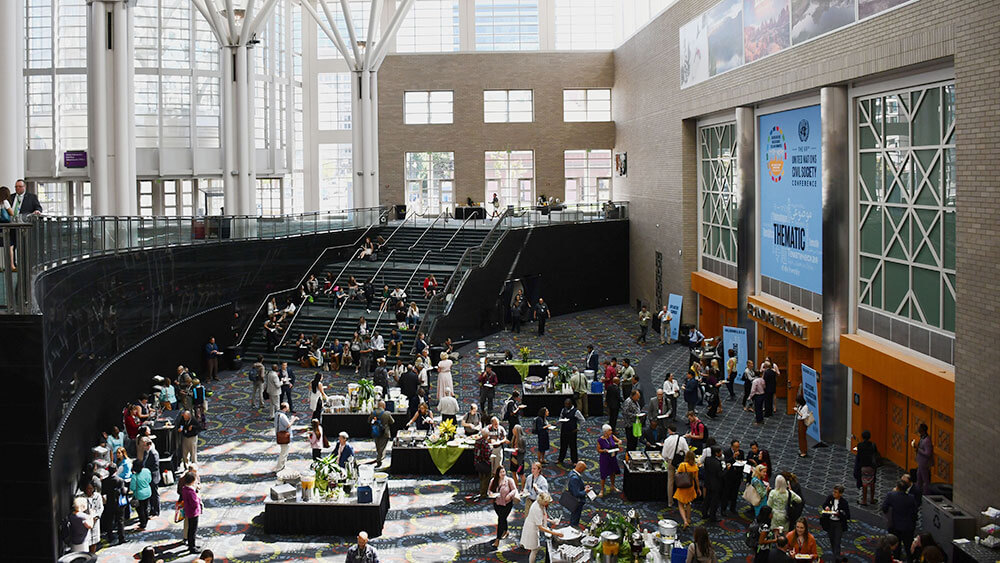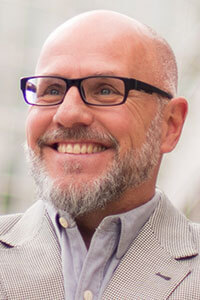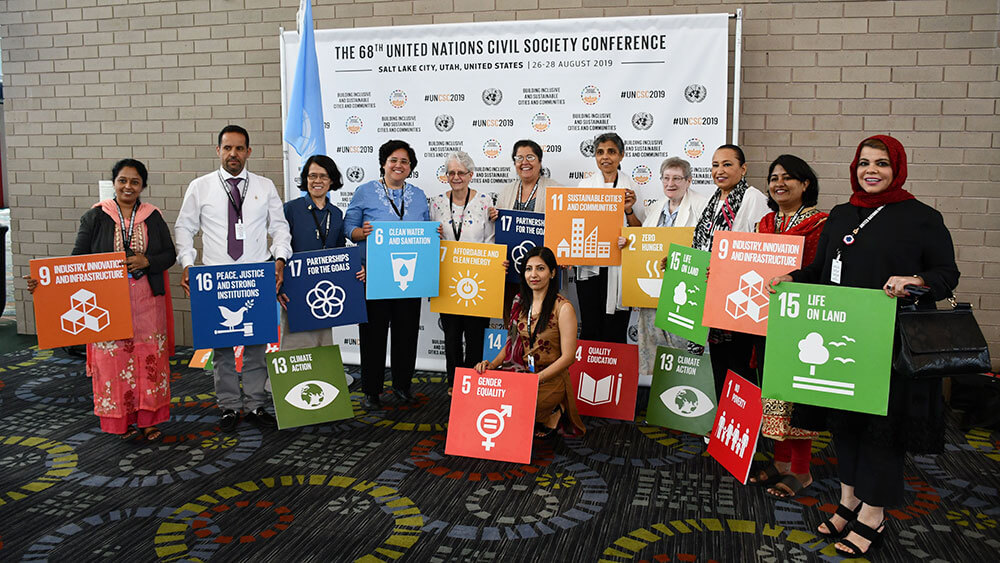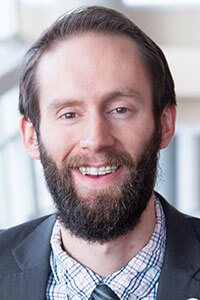
Attendees at the UN Civil Society Conference get breakfast at the Salt Palace Convention Center, which hosted the August event. (Sean Buckley/Visit Salt Lake)
Despite its long history, the United Nations Civil Society Conference — in its 68th edition — was held for the first time in the U.S. in Salt Lake in August. While the conference has been held at the United Nations in New York City, the building is not considered to be on American soil. In a sense, Salt Lake would be making history with this event — yet the city learned it was chosen to host the conference only one year before it came to town.
“There was nothing that we were given as a community in terms of an RFP,” said Scott Beck, who served as Visit Salt Lake president and CEO at the time of this interview. (As Convene‘s October issue was going to press, Beck was named president and CEO of Tourism Toronto.)
“What we knew was that registration is free and the biggest event they’d ever had was 3,000 people.” Salt Lake City ended up welcoming upwards of 5,000 attendees. Convene recently spoke with Beck, as well as Chance Thompson, senior manager, sustainability and public relations, SMG, which manages the Salt Palace Convention Center, to learn how the destination and facility came together to host a zero-emission event for the UN.
Scott Beck

Scott Beck
Why was Salt Lake a desirable location for the UN Civil Society Conference?
Going back to the 2002 Winter Olympics, we signed a pact as a destination to produce the single-most sustainable Olympics ever. We set very high benchmarks for the sustainability efforts of our community in and around the Olympics. That set us on a trajectory that to this day is still very much alive and a part of who we are as a community. Going back a couple of mayors to Mayor Ralph Becker and his initiatives around reducing the carbon footprint of the city, [like] going to an electrical fleet, working on all new buildings being [LEED] certified, if not at a gold level, at a platinum level, zero-emission buildings.
We’ve been recognized as a community who’s really trying to make leaps and bounds towards a better stewardship of our natural environment. Our Mayor Jackie Biskupski was invited to speak at the UN about a year and a half ago on the issue around what cities are doing to reduce the impacts of — and how they can have a positive effect on — climate change. The Department of Public Information (DPI) communications director came up to her after and said, “Very impressed. You guys would be a great community for this event that we host around Civil Society.”
How did Salt Lake work with the UN Civil Society Conference organizers to create a sustainable event?
This was the first time the UN didn’t have a printed program or a printed outcome document. We used our app technology that we have through our CRM, which is Simpleview, and we had nearly 3,000 downloads of the app, which was absolutely mind-boggling. And along the way, we made various commitments to be true to this idea that there’s a better [and more sustainable] way [to hold a conference]. At registration, the traditional bag with all the paper stuff in it and all those sponsor recognitions, there was none of that. Signage was adequate, but at a very strategic level. There weren’t signs every five feet. All the signs are being recycled and repurposed and reused.
The UN let us go all in … on all of the things our industry has talked about for at least the last 10 years, like no bottled water. The only thing that [attendees] received at registration was a reusable, refillable water bottle.
Is the hope that this conference will serve as a case study for future events that come to the city to show how sustainable a meeting can be?
Yeah, and I don’t want to give an entirely rosy picture. Maybe there was a certain demographic at the convention that really did not respond well to no printed programs, but we had large video screens with the workshops and the content rolling on it like you see at the airport. I mean there were things that we did — it wasn’t just like download the app or die. There were things that we did that event professionals do — not all the time, but there are pockets of people doing very, very sustainable events.
At its scope and scale, this event for us was unique because it was all in. We had people on staff making sure that our diversion rate was above 80 percent for trash. We had recycling of food, donation of exhibit equipment and exhibit supplies. It just was one of those things where we could check every one of those boxes.
We’re trying to make sure that the legacy of this event is the most sustainable event that the UN has ever done. The next time they do this [event], we’re going to have a document for its [host] city that says, “Here’s what we did. Here’s where we pushed the UN. Here’s where the UN pushed us. Here’s our budget. Here’s our layout. Here’s everything we did,” and hopefully all those things we’ve done, the next city can kind of do the same thing.
Is there anything that you learned from hosting this event that you weren’t expecting?
I was very inspired by the UN’s welcoming nature around divisive topics. The chair of the whole entire event stood up in front of everyone at the closing plenary and said, “This is diversity.”

More than 5,000 people attended the UN Civil Society Conference in August, which included a program devoted to building inclusive and sustainable cities and communities. (Sean Buckley/Visit Salt Lake)
Chance Thompson

Chance Thompson
How did Salt Palace Convention Center work to make this event as sustainable as possible?
There were a number of different things that we really focused on, some very standard for us and part of what we do for every client. And then there’s another kind of element that’s very unique that we wanted to get out in front of the UN. With their goal of the entire conference being centered around their SDG [Sustainable Development Goal] No. 11: Sustainable Cities and Communities, that is an area where we found a lot of strength in our programming. Out at the Salt Palace, we have five different organizations [including SMG, PSAV, Visit Salt Lake, and Utah Food Services] that partner together on what we call our “green team” that carries out sustainable hospitality, sustainable events.
The area where we found our greatest opportunity and kind of really full-steam-ahead approach was the materials management side — the waste management, the recycling. And the reason that has been so successful for us is that we designed a community-impact program. Leftover trade-show material that the client can’t repurpose or reuse on their side, which we encourage first and foremost, of course, we connect to our local community through the 501(c)(3) arts and theater programs, school districts, theater companies, faith-based organizations, and so on — they receive that material and they put it to use.
The UN conference, because of their ethos, has really made our job pretty dang easy. They were really diligent about trying not to have a lot of waste and for the most part, really the only thing we’re looking at is signage and banners. But [most of] their exhibitors were local community groups, so they took all of their exhibit show materials with them. I don’t honestly know if I’ve ever seen our recycling stream look so clean. I was looking at one of the cardboard streams and I was like, “Where’s the garbage?”
Climate Debate: Caring for the Planet vs. Flying to Conferences
Also, Utah Food Services is probably our most sustainable company out of our green team. They’ve been doing some of this stuff for years and years and they have a really cool food-donation program. They do their best to keep food off the line, keep it back of house, at hot or cold temperatures, and then only serve that food as it is needed — that way they’re able to donate it. And we work with a local organization called Waste Less Solutions, which specializes in food pickup and delivery through donation. What is left — because there’s always going to be a little bit left over to make sure that you’ve prepared enough for your attendees — will be donated and/or digested into methane and then natural gas.
In terms of sustainability, how was this kind of event different from other events at the center?
They were very proactive on their side without prompting from us. They were already trying to eliminate plastic from their planning process, being a valuable partner on food management and food rescue and things like that. And so that’s super proactive because a lot of times when you’re talking to clients, big trade shows, they haven’t really thought that much about this stuff yet. They probably have a decorator that will do some responsible recycling and maybe a little donation program here and there. But so often, we’re really opening a new conversation for them and often- times trying to kind of inspire and get them excited about it so that they’ll do some kind of grand things around it.
What’s different as well is the attendee base. I saw so many attendees with reusable water bottles and mugs and just very little waste. We could focus on doing everything really well rather than trying to educate and bring the client online as we went.
What did you learn from hosting the UN Civil Society Conference?
They really sparked us to grab ahold of kind of what true sustainability is — because for us, at least my role, primarily was focused on the environmental components and the climate action pieces. But we’re starting to incorporate more branding around the social and people side of sustainability, looking at equality and hospitality and accessibility.
And then of course, we’re here to drive economic impact, smart business, and responsible growth. And so it really helped us adopt what I would consider to be a truly triple bottom line. The UN really gave us that platform because it’s visual — you look at all 17 of those SDGs and you’re like, “That’s what sustainability is.” And everybody can look at that graphic and they can either get it all or they can take three of them and say, “You know, we really care about these things. We’re gonna focus on this stuff.” We’ve been cautioned that it’s ambitious. to have 17 goals or pledges as an organization, and we say, “All right, let’s do it.”
Casey Gale is an associate editor at Convene.
These interviews have been edited and condensed for print.
